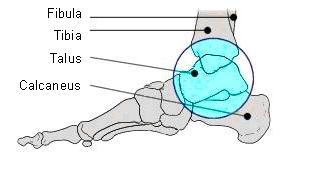Ankle osteochondral lesions
What are osteochondral lesions?
An osteochondral lesion is an injury to the bone underneath the surface of a joint. It usually starts as a bruise in the bone (called a grade 1 lesion) but it may lead to a hole or crater when a piece of bone has broken off (grade 4). These defects can occur in various joints of the body – knee, elbow, hip or ankle. In the ankle they almost always affect the ankle bone, or talus, which forms the main ankle joint where it meets the shinbones. Normally, the shiny articular cartilage which covers the ends of all joint bones protects the bones. However, the underlying lesion in the bone can cause the cartilage to soften and degenerate.
OC lesions differ from osteoarthritis for the following reasons: they are a specific, localised bone defect, rather than a wider degeneration of the joint surface; and they mainly occur on the talus rather than on both sides of the joint. However, large OC lesions (and the associated degeneration in the quality of the cartilage) can lead over time to the development of ankle osteoarthritis.
What causes it?
The main cause of OC lesions seems to be a previous ankle sprain. When you sprain your ankle the talus may rub or hit against the shinbone (tibia) which causes damage on the point of impact. Indeed, most patients who have an OC lesion have had a previous ankle sprain which didn’t seem to heal properly, and which caused persistent pain and instability.
How does it feel?
In the early stages of the development of a defect, you may not have any pain. However as it develops you will have pain when you are on your feet, and often also when you are resting. There may also be swelling round the ankle. The ankle joint may feel unstable as if it won’t hold your weight, or it may feel as if it ‘catches’ when you walk.
Diagnosis
Your doctor will ask you about your medical history, and he will make a physical examination of your ankle. He may also ask for X-rays and an MRI scan of the ankle.
Treatment – conservative
As there are various types of lesion, some more serious than others, treatment will depend on the severity of the lesion. If the talus is only bruised, your doctor will prescribe rest, shock wave therapy or magnetotherapy. However, in most cases an OC lesion is only diagnosed once the bone damage is more serious (i.e. a wide cyst has formed or a piece of bone has broken off) and so surgical treatment may be required to treat the problem.
Treatment – surgical
Depending on the size and seriousness of the defect your surgeon may carry perform one of the following procedures.
– Arthroscopic Debridement: this is carried out on less damaged areas and is aimed at preventing or delaying further progression of the problem. The surgeon makes 2 small incisions on the ankle through which he will clean up the joint, trimming any rough edges of cartilage, and removing the inflamed synovium.
– Osteochondral Fragment Stabilisation: in more serious cases when there is an osteochondral fragment, he will either drill into it to encourage healing (if it is still firmly attached to the bone), or if it is loosely attached or even has come away, he will fix it back with absorbable pins or screws.
Rehabilitation after surgery
If your surgeon has only had to tidy up the joint during debridement, you will only need to walk with crutches for the first week. However, if you have undergone any of the procedures for osteochondral fragments you need to wait 4-8 weeks before being able to walk without crutches. You will start physiotherapy almost immediately to recover your range of movement, and to strengthen your muscles.
When will I be back to normal?
You will be able to drive again after a week. After a normal debridement you can go back to office work almost immediately and manual work after 14 days. However if you had treatment for OC fragments you will need to wait a week for office work and 45-60 days for manual work.
You can start light sporting activity after about a week, although patients with OC fragments will need to wait 4-6 weeks before attempting any sporting activity.
You should consult your doctor before returning to contact sports, although it will be anything from 4 to 12 weeks – depending on the procedures your surgeon has had to perform.
